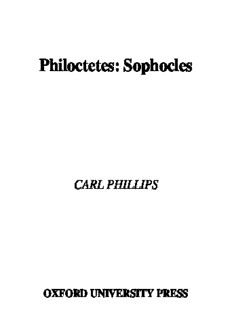
Philoctetes (Greek Tragedy in New Translations) PDF
Preview Philoctetes (Greek Tragedy in New Translations)
Philoctetes: Sophocles CARL PHILLIPS OXFORD UNIVERSITY PRESS THE GREEK TRAGEDY IN NEW TRANSLATIONS GENERAL EDITORS Peter Burian and Alan Shapiro SOPHOCLES: Philoctetes This page intentionally left blank SOPHOCLES Philoctetes Translated by CARL PHILLIPS With Introduction and Notes by DISKIN CLAY 1 2003 1 Oxford NewYork Auckland Bangkok BuenosAires CapeTown Chennai DaresSalaam Delhi HongKong Istanbul Karachi Kolkata KualaLumpur Madrid Melbourne MexicoCity Mumbai Nairobi Sa˜oPaulo Shanghai Taipei Tokyo Toronto Copyright(cid:1)2003byOxfordUniversityPress,Inc. PublishedbyOxfordUniversityPress,Inc. 198MadisonAvenue,NewYork,NewYork10016 www.oup.com OxfordisaregisteredtrademarkofOxfordUniversityPress Allrightsreserved.Nopartofthispublicationmaybereproduced, storedinaretrievalsystem,ortransmitted,inanyformorbyanymeans, electronic,mechanical,photocopying,recording,orotherwise, withoutthepriorpermissionofOxfordUniversityPress. LibraryofCongressCataloging-in-PublicationData Sophocles. [Philoctetes.English] Philoctetes/Sophocles;translatedbyCarlPhillips; withintroductionandnotesbyDiskinClay. p. cm.—(TheGreektragedyinnewtranslations) ISBN0-19-513657-8 1. Philoctetes(Greekmythology)—Drama. 2. TrojanWar—Drama. I. Title:Sophocles—Philoctetes. II. Phillips,Carl,1959– III. Clay,Diskin. IV. Title. V. Series. PA4414.P5P48 2003 882'.01—dc21 2002032763 987654321 PrintedintheUnitedStatesofAmerica EDITORS’ FOREWORD “The Greek Tragedy in New Translations is based on the conviction that poets like Aeschylus, Sophocles, and Euripides canonlybeprop- erlyrenderedbytranslatorswhoarethemselvespoets.Scholarsmay,it is true, produce useful and perceptive versions. But our most urgent present need is for a re-creation of these plays—as though they had been written, freshly and greatly, by masters fully at home in the En- glish of our own times.” Withthesewords,thelateWilliamArrowsmithannouncedthepur- pose of this series, and we intend to honor that purpose. As was true of most of the volumes that began to appearin the1970s—firstunder Arrowsmith’s editorship, later in association with Herbert Golder— those for which we bear editorial responsibility are products of close collaboration between poets and scholars. We believe (as Arrowsmith did) that the skills of both are required for the difficult and delicate task of transplanting these magnificent specimens of another culture into the soil of our own place and time, to do justice both to their deep differences from our patterns of thought and expression and to their palpable closeness to our most intimate concerns. Above all, we areeagertooffercontemporaryreadersdramaticpoemsthatconveyas vividlyanddirectlyaspossiblethesplendoroflanguage,thecomplexity of image and idea, and the intensity of emotion of the originals.This entails, among much else, the recognition that the tragedies were meant for performance—as scripts for actors—to be sung and danced as well as spoken. It demands writing of inventiveness, clarity, musi- cality, and dramatic power. By such standards we ask that thesetrans- lations be judged. This series is also distinguished by its recognition of the need of nonspecialist readers for a critical introduction informed by the best recent scholarship, but written clearly and without condescension. v EDITORS’ FOREWORD Each play is followedbynotesdesigned not onlytoelucidateobscure references but also to mediate the conventions of the Athenian stage as well as those features of the Greek text that might otherwise go unnoticed. The notes are supplemented by a glossaryofmythicaland geographicaltermsthatshouldmakeitpossibletoreadtheplaywithout turning elsewhere for basic information. Stage directions are suffi- cientlyampletoaidreadersinimaginingtheactionastheyread.Our fondest hope, of course, is that these versions will be staged not only inthemindsoftheirreadersbutalsointhetheaterstowhich,afterso many centuries,they still belong. a note on the series format A series such as this requires aconsistentformat.Differenttranslators, withindividualvoicesandapproachestothematerialinhand,cannot be expected to develop a single coherent style for each of the three tragedians, much less make clear to modern readers that, despite the differencesamongthetragediansthemselves,theplayssharemanycon- ventions and a generic, or period, style. But they can at least share a common formatand providesimilarformsof guidance to the reader. 1. Spelling of Greek names Orthography is one area of difference among the translations that re- quires a brief explanation. Historically, it has been common practice to use Latinized forms of Greek names when bringing them into En- glish. Thus, for example, Oedipus (not Oidipous) and Clytemnestra (notKlutaimestra)arecustomaryinEnglish.Recently,however,many translators have moved toward more precise transliteration, whichhas theadvantageofpresentingthenamesasbothGreekandnew,instead ofRomanandneoclassicalimportationsintoEnglish.Inthecaseofso familiar a name as Oedipus, however, transliteration risks the appear- ance of pedantry or affectation. And in any case, perfect consistency cannotbeexpectedinsuchmatters.Readerswillfeelthesamediscom- fort with “Athenai” as the chief city of Greece as they would with “Platon” as the author of the Republic. The earlier volumes in this series adopted as a rule a “mixed” or- thography in accordance with the considerations outlined above. The most familiar names retain their Latinate forms, therestaretransliter- ated;–os rather than Latin–us is adopted for the termination of mas- culine names, and Greek diphthongs (such as Iphigeneia for Latin Iphigenia)areretained.Someofthelatervolumescontinuethisprac- tice,butwheretranslatorshavepreferredtouseamoreconsistentprac- tice of transliterationor Latinization,we have honored their wishes. vi EDITORS’ FOREWORD 2. Stage directions TheancientmanuscriptsoftheGreekplaysdonotsupplystagedirec- tions(thoughtheancientcommentatorsoftenprovideinformationrel- evanttostaging,delivery,“blocking,”etc.).Hencestagedirectionsmust be inferred from words and situations and our knowledge of Greek theatrical conventions. At best this is a ticklish and uncertain proce- dure. But it is surely preferable that good stage directions should be providedbythetranslatorthanthatreadersshouldbelefttotheirown devices in visualizing action, gesture, and spectacle. Ancient tragedy wasaustereand“distanced”bymeansofmasks,whichmeansthatthe reader must not expect the detailed intimacy (“He shrugs and turns wearily away,” “She speaks with deliberate slowness, asthoughtoem- phasize the point,” etc.) that characterizes stage directions in modern naturalisticdrama. 3. Numberingof lines For the convenience of the reader who may wish to check the trans- lationagainsttheoriginal,orviceversa,thelineshavebeennumbered according to boththe Greek andEnglish texts.Thelinesofthetrans- lation have been numbered in multiples of ten, and those numbers have been set in the right-hand margin. The (inclusive) Greek nu- meration will be found bracketed at the top of the page. The Notes that follow the text have been keyed to both numerations, the line numbers of the translation in bold, followed by the Greek line num- bersinregulartype,andthesameconventionisusedforallreferences tospecificpassages(ofthetranslatedplaysonly)inboththeNotesand the Introduction. Readers will doubtless note that in many plays the English lines outnumbertheGreek,buttheyshouldnotthereforeconcludethatthe translator has been unduly prolix. In some cases the reason is simply thatthetranslatorhasadoptedthefree-flowingnormsofmodernAnglo- American prosody, with its brief-breath- and emphasis-determined lines, and its habit of indicating cadence and caesuras by line length andsettingratherthanbyconventionalpunctuation.Evenwheretrans- lators have preferred to cast dialogue in more regular five-beat or six- beat lines, the greater compactness of Greek diction is likely to result in a substantialdisparityin Greek and English numerations. Durham, N.C. Peter Burian Chapel Hill, N.C. Alan Shapiro 2003 vii This page intentionally left blank CONTENTS Introduction, 3 On the Translation, 25 Characters, 32 Philoctetes, 33 Notes on the Text, 99 Glossary, 115 ix
Description: